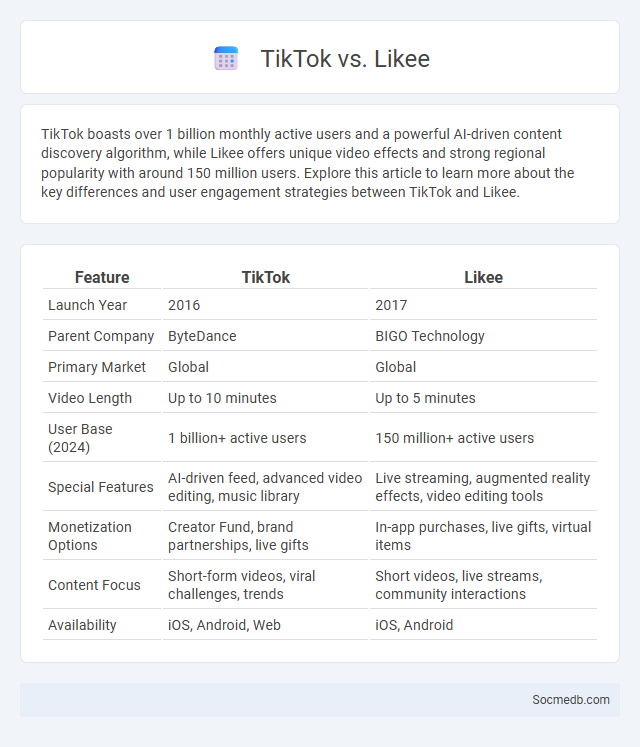
Photo illustration: TikTok vs Likee
TikTok boasts over 1 billion monthly active users and a powerful AI-driven content discovery algorithm, while Likee offers unique video effects and strong regional popularity with around 150 million users. Explore this article to learn more about the key differences and user engagement strategies between TikTok and Likee.
Table of Comparison
| Feature | TikTok | Likee |
|---|---|---|
| Launch Year | 2016 | 2017 |
| Parent Company | ByteDance | BIGO Technology |
| Primary Market | Global | Global |
| Video Length | Up to 10 minutes | Up to 5 minutes |
| User Base (2024) | 1 billion+ active users | 150 million+ active users |
| Special Features | AI-driven feed, advanced video editing, music library | Live streaming, augmented reality effects, video editing tools |
| Monetization Options | Creator Fund, brand partnerships, live gifts | In-app purchases, live gifts, virtual items |
| Content Focus | Short-form videos, viral challenges, trends | Short videos, live streams, community interactions |
| Availability | iOS, Android, Web | iOS, Android |
TikTok vs Likee: Platform Overview
TikTok boasts over 1 billion active users worldwide, driven by its short-form video content, advanced AI-driven personalized feeds, and extensive creator monetization options. Likee, with approximately 150 million monthly active users, emphasizes augmented reality effects and live-streaming features targeting emerging markets. TikTok's algorithm excels in content discovery, significantly outperforming Likee in user engagement and global reach.
Key Features Comparison: TikTok and Likee
TikTok offers advanced AI-driven content recommendations and a vast library of music and effects, enhancing your video creation experience. Likee provides extensive video editing tools with real-time effects and supports interactive features like live streaming and 4D magic effects. Both platforms prioritize user engagement but differ in their unique features, making it essential to choose based on your content style and audience interaction preferences.
User Demographics and Audience Reach
Understanding social media user demographics is essential for maximizing your content's effectiveness and targeting the right audience segments based on age, gender, location, and interests. Platforms such as Facebook, Instagram, TikTok, and LinkedIn each attract distinct user profiles, enabling tailored marketing strategies that increase engagement and brand visibility. Your ability to analyze audience reach data allows you to optimize campaign performance and connect with the most relevant users for higher conversion rates.
Content Creation Tools and Effects
Content creation tools enhance your ability to design engaging social media posts through features like customizable templates, advanced photo editing, and video filters that increase visual impact. These tools support AI-driven suggestions and analytics to optimize content performance and audience engagement across platforms like Instagram, TikTok, and Facebook. Leveraging effects such as augmented reality filters and animated graphics boosts interactivity and attracts more followers to your social media profile.
Algorithm & Content Discovery
Social media algorithms analyze your behavior and preferences to curate personalized content feeds that enhance engagement and retention. These algorithms prioritize content discovery by ranking posts based on relevance, popularity, and timeliness, helping you find trending topics and communities. Optimizing your content for algorithmic visibility increases audience reach and interaction on platforms like Facebook, Instagram, and TikTok.
Monetization Options for Creators
Social media platforms offer diverse monetization options for creators, including ad revenue sharing, brand partnerships, and subscription-based content. You can also benefit from fan support features like tipping, merchandise sales, and exclusive content access through platforms such as YouTube, Instagram, and Patreon. Maximizing these opportunities helps boost your income streams while growing your audience engagement.
Community Engagement Strategies
Community engagement strategies on social media enhance Your brand's visibility by fostering authentic interactions and building loyalty through consistent, value-driven content. Utilizing targeted hashtags, interactive polls, and timely responses to comments encourages active participation and strengthens relationships within Your audience. Leveraging data analytics to monitor engagement patterns allows optimization of posts for maximum reach and meaningful connection.
Cross-Platform Promotion: Best Practices
Effective cross-platform promotion involves tailoring content to each social media network's unique audience and format, ensuring consistency in brand messaging across channels like Instagram, Twitter, Facebook, and LinkedIn. Utilizing tools such as buffer or Hootsuite streamlines scheduling and performance tracking, enhancing engagement and reach. Strategic use of hashtags, compelling visuals, and platform-specific features like Instagram Stories or LinkedIn articles maximizes visibility and drives audience interaction.
Case Studies: Successful Multi-Platform Campaigns
Successful multi-platform social media campaigns leverage diverse channels like Instagram, Twitter, Facebook, and TikTok to maximize audience engagement and brand visibility. Case studies from brands such as Nike's "Dream Crazy" campaign and Spotify's "Wrapped" reveal strategic content tailoring and real-time interaction as key factors driving viral reach and user participation. Analytics indicate that integrating visual storytelling with data-driven targeting across platforms significantly enhances conversion rates and social ROI.
Future Trends in Social Video Marketing
Future trends in social video marketing emphasize immersive experiences like augmented reality (AR) and virtual reality (VR) to boost engagement and brand interaction. Short-form videos dominate platforms such as TikTok, Instagram Reels, and YouTube Shorts, driving higher viewer retention and viral potential. Interactive features, including shoppable videos and real-time live streaming, enhance consumer participation and conversion rates in digital campaigns.
 socmedb.com
socmedb.com